Business Research Methodology: Leadership and Engagement at Wesfarmers
VerifiedAdded on 2022/09/23
|11
|2484
|41
Report
AI Summary
This research proposal investigates the impact of leadership styles on employee engagement, specifically focusing on a case study of Wesfarmers, Australia. The study explores the conceptual understanding of leadership styles and employee engagement, addressing specific research questions concerning the roles of different leadership approaches, including transformational and transactional styles. The methodology involves applied research, utilizing a mixed-methods design with both qualitative and quantitative data collection through surveys and questionnaires. The research aims to analyze the relationship between leadership styles and employee engagement, proposing strategies to improve leadership effectiveness and ultimately enhance employee engagement within the organization. The proposal includes a detailed literature review, research questions, hypotheses, and a discussion of the research philosophy, approach, strategy, design, data collection, sampling, data analysis methods, and ethical considerations.
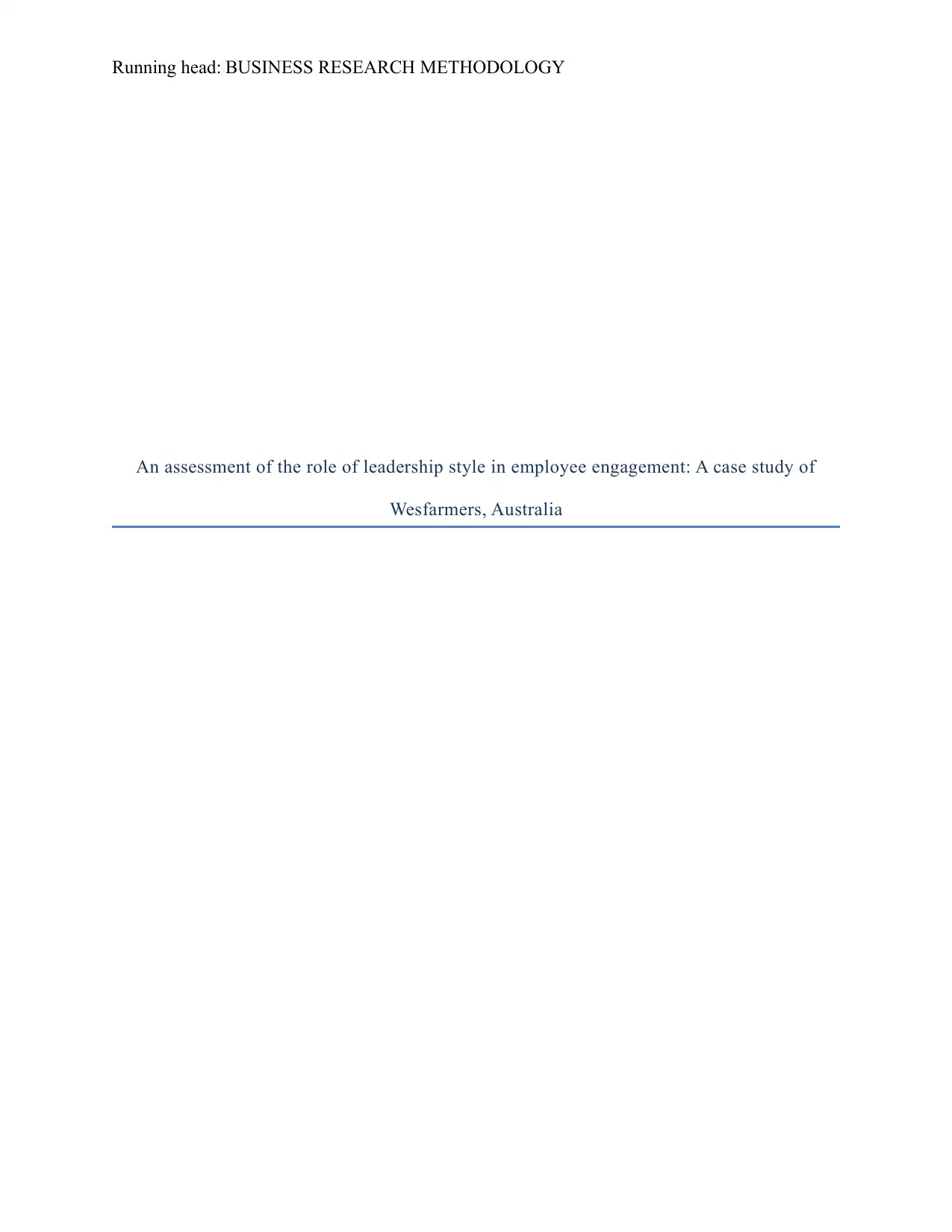
Running head: BUSINESS RESEARCH METHODOLOGY
An assessment of the role of leadership style in employee engagement: A case study of
Wesfarmers, Australia
An assessment of the role of leadership style in employee engagement: A case study of
Wesfarmers, Australia
Paraphrase This Document
Need a fresh take? Get an instant paraphrase of this document with our AI Paraphraser
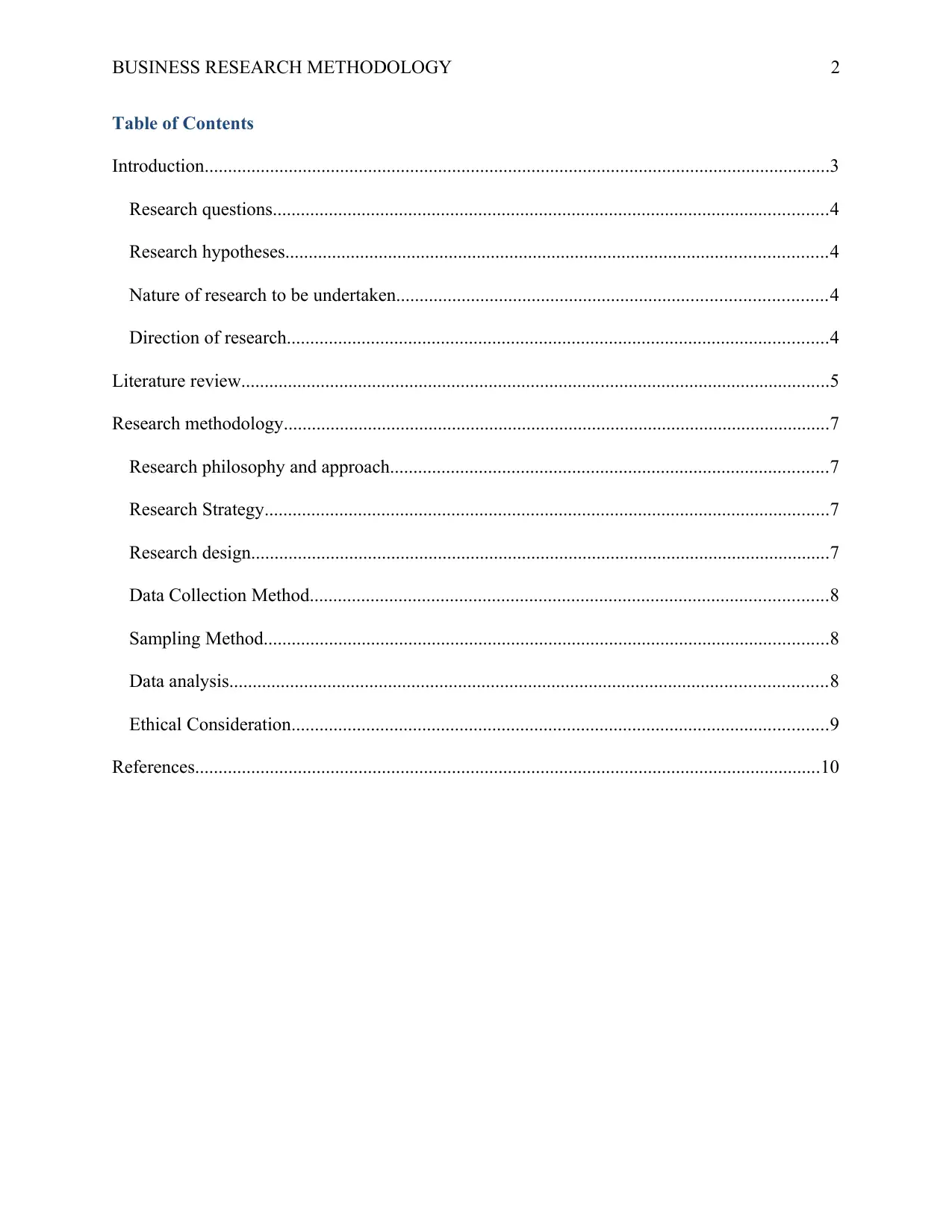
BUSINESS RESEARCH METHODOLOGY 2
Table of Contents
Introduction......................................................................................................................................3
Research questions.......................................................................................................................4
Research hypotheses....................................................................................................................4
Nature of research to be undertaken............................................................................................4
Direction of research....................................................................................................................4
Literature review..............................................................................................................................5
Research methodology.....................................................................................................................7
Research philosophy and approach..............................................................................................7
Research Strategy.........................................................................................................................7
Research design............................................................................................................................7
Data Collection Method...............................................................................................................8
Sampling Method.........................................................................................................................8
Data analysis................................................................................................................................8
Ethical Consideration...................................................................................................................9
References......................................................................................................................................10
Table of Contents
Introduction......................................................................................................................................3
Research questions.......................................................................................................................4
Research hypotheses....................................................................................................................4
Nature of research to be undertaken............................................................................................4
Direction of research....................................................................................................................4
Literature review..............................................................................................................................5
Research methodology.....................................................................................................................7
Research philosophy and approach..............................................................................................7
Research Strategy.........................................................................................................................7
Research design............................................................................................................................7
Data Collection Method...............................................................................................................8
Sampling Method.........................................................................................................................8
Data analysis................................................................................................................................8
Ethical Consideration...................................................................................................................9
References......................................................................................................................................10
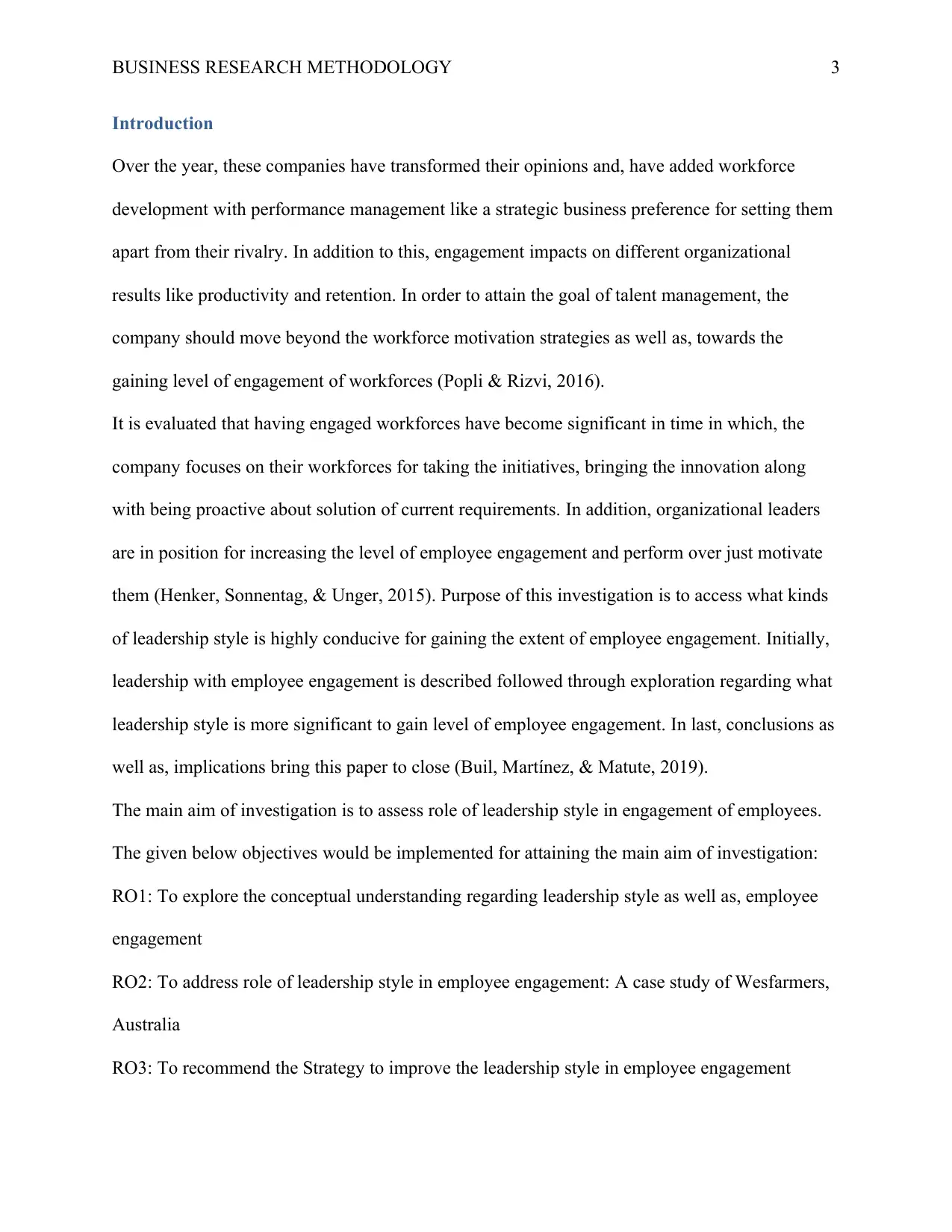
BUSINESS RESEARCH METHODOLOGY 3
Introduction
Over the year, these companies have transformed their opinions and, have added workforce
development with performance management like a strategic business preference for setting them
apart from their rivalry. In addition to this, engagement impacts on different organizational
results like productivity and retention. In order to attain the goal of talent management, the
company should move beyond the workforce motivation strategies as well as, towards the
gaining level of engagement of workforces (Popli & Rizvi, 2016).
It is evaluated that having engaged workforces have become significant in time in which, the
company focuses on their workforces for taking the initiatives, bringing the innovation along
with being proactive about solution of current requirements. In addition, organizational leaders
are in position for increasing the level of employee engagement and perform over just motivate
them (Henker, Sonnentag, & Unger, 2015). Purpose of this investigation is to access what kinds
of leadership style is highly conducive for gaining the extent of employee engagement. Initially,
leadership with employee engagement is described followed through exploration regarding what
leadership style is more significant to gain level of employee engagement. In last, conclusions as
well as, implications bring this paper to close (Buil, Martínez, & Matute, 2019).
The main aim of investigation is to assess role of leadership style in engagement of employees.
The given below objectives would be implemented for attaining the main aim of investigation:
RO1: To explore the conceptual understanding regarding leadership style as well as, employee
engagement
RO2: To address role of leadership style in employee engagement: A case study of Wesfarmers,
Australia
RO3: To recommend the Strategy to improve the leadership style in employee engagement
Introduction
Over the year, these companies have transformed their opinions and, have added workforce
development with performance management like a strategic business preference for setting them
apart from their rivalry. In addition to this, engagement impacts on different organizational
results like productivity and retention. In order to attain the goal of talent management, the
company should move beyond the workforce motivation strategies as well as, towards the
gaining level of engagement of workforces (Popli & Rizvi, 2016).
It is evaluated that having engaged workforces have become significant in time in which, the
company focuses on their workforces for taking the initiatives, bringing the innovation along
with being proactive about solution of current requirements. In addition, organizational leaders
are in position for increasing the level of employee engagement and perform over just motivate
them (Henker, Sonnentag, & Unger, 2015). Purpose of this investigation is to access what kinds
of leadership style is highly conducive for gaining the extent of employee engagement. Initially,
leadership with employee engagement is described followed through exploration regarding what
leadership style is more significant to gain level of employee engagement. In last, conclusions as
well as, implications bring this paper to close (Buil, Martínez, & Matute, 2019).
The main aim of investigation is to assess role of leadership style in engagement of employees.
The given below objectives would be implemented for attaining the main aim of investigation:
RO1: To explore the conceptual understanding regarding leadership style as well as, employee
engagement
RO2: To address role of leadership style in employee engagement: A case study of Wesfarmers,
Australia
RO3: To recommend the Strategy to improve the leadership style in employee engagement
⊘ This is a preview!⊘
Do you want full access?
Subscribe today to unlock all pages.

Trusted by 1+ million students worldwide
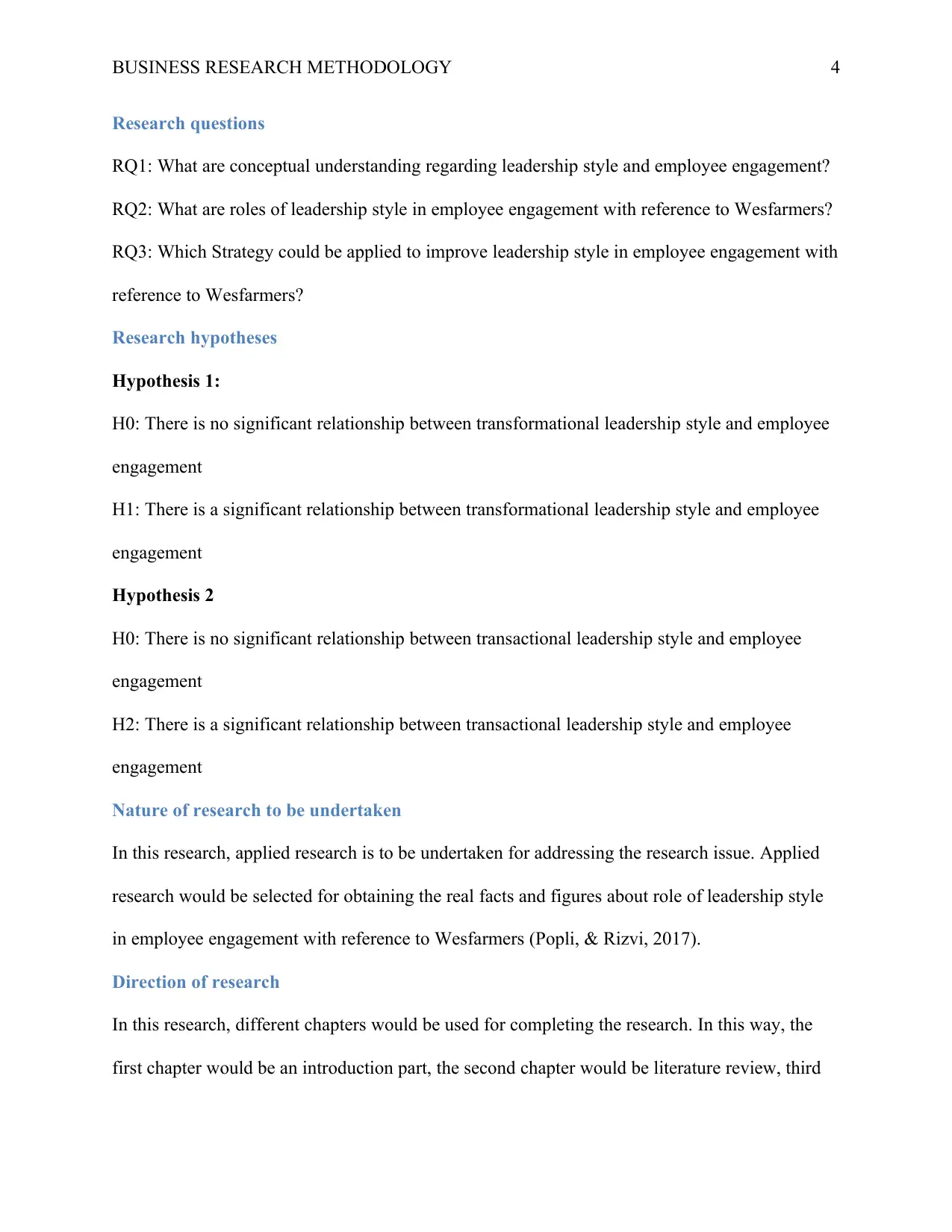
BUSINESS RESEARCH METHODOLOGY 4
Research questions
RQ1: What are conceptual understanding regarding leadership style and employee engagement?
RQ2: What are roles of leadership style in employee engagement with reference to Wesfarmers?
RQ3: Which Strategy could be applied to improve leadership style in employee engagement with
reference to Wesfarmers?
Research hypotheses
Hypothesis 1:
H0: There is no significant relationship between transformational leadership style and employee
engagement
H1: There is a significant relationship between transformational leadership style and employee
engagement
Hypothesis 2
H0: There is no significant relationship between transactional leadership style and employee
engagement
H2: There is a significant relationship between transactional leadership style and employee
engagement
Nature of research to be undertaken
In this research, applied research is to be undertaken for addressing the research issue. Applied
research would be selected for obtaining the real facts and figures about role of leadership style
in employee engagement with reference to Wesfarmers (Popli, & Rizvi, 2017).
Direction of research
In this research, different chapters would be used for completing the research. In this way, the
first chapter would be an introduction part, the second chapter would be literature review, third
Research questions
RQ1: What are conceptual understanding regarding leadership style and employee engagement?
RQ2: What are roles of leadership style in employee engagement with reference to Wesfarmers?
RQ3: Which Strategy could be applied to improve leadership style in employee engagement with
reference to Wesfarmers?
Research hypotheses
Hypothesis 1:
H0: There is no significant relationship between transformational leadership style and employee
engagement
H1: There is a significant relationship between transformational leadership style and employee
engagement
Hypothesis 2
H0: There is no significant relationship between transactional leadership style and employee
engagement
H2: There is a significant relationship between transactional leadership style and employee
engagement
Nature of research to be undertaken
In this research, applied research is to be undertaken for addressing the research issue. Applied
research would be selected for obtaining the real facts and figures about role of leadership style
in employee engagement with reference to Wesfarmers (Popli, & Rizvi, 2017).
Direction of research
In this research, different chapters would be used for completing the research. In this way, the
first chapter would be an introduction part, the second chapter would be literature review, third
Paraphrase This Document
Need a fresh take? Get an instant paraphrase of this document with our AI Paraphraser
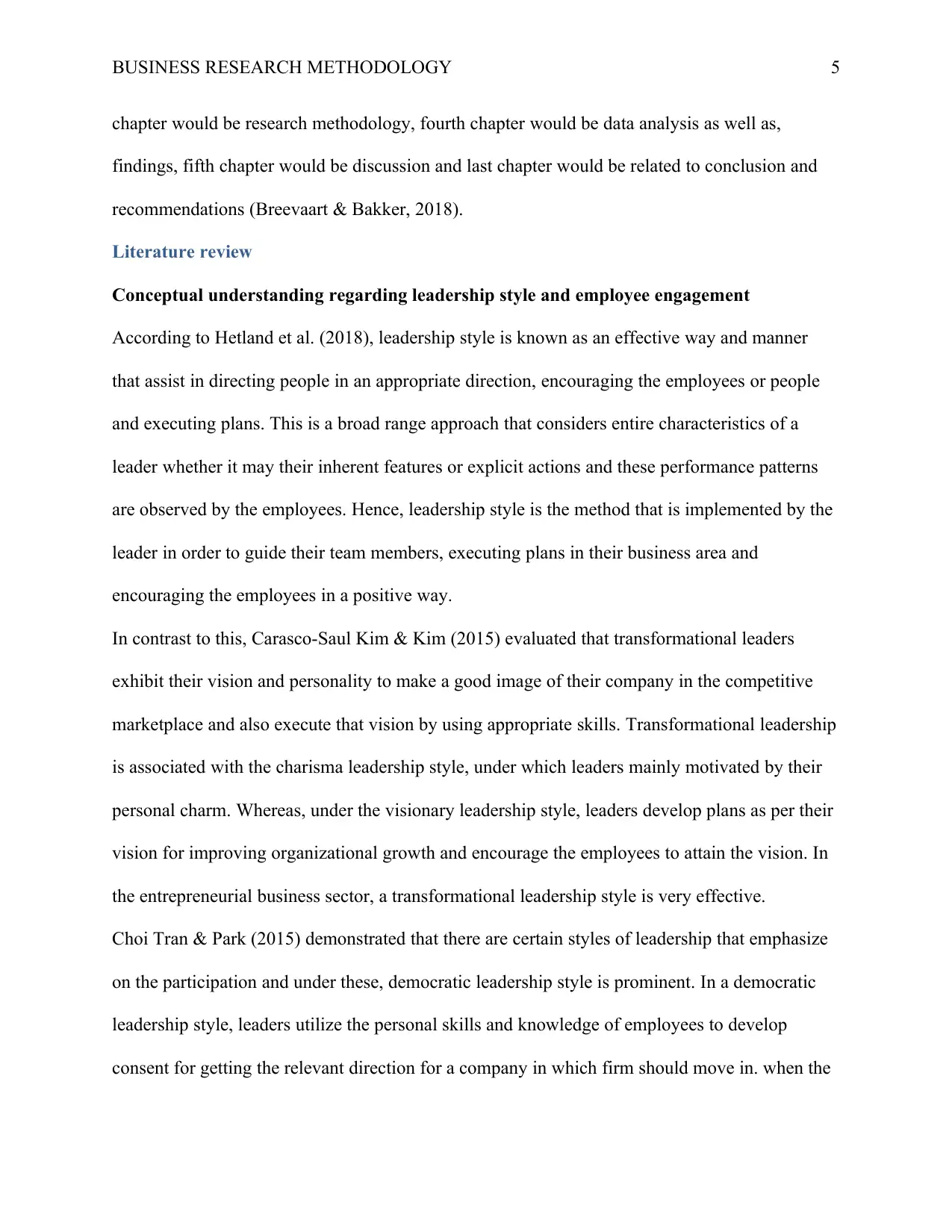
BUSINESS RESEARCH METHODOLOGY 5
chapter would be research methodology, fourth chapter would be data analysis as well as,
findings, fifth chapter would be discussion and last chapter would be related to conclusion and
recommendations (Breevaart & Bakker, 2018).
Literature review
Conceptual understanding regarding leadership style and employee engagement
According to Hetland et al. (2018), leadership style is known as an effective way and manner
that assist in directing people in an appropriate direction, encouraging the employees or people
and executing plans. This is a broad range approach that considers entire characteristics of a
leader whether it may their inherent features or explicit actions and these performance patterns
are observed by the employees. Hence, leadership style is the method that is implemented by the
leader in order to guide their team members, executing plans in their business area and
encouraging the employees in a positive way.
In contrast to this, Carasco-Saul Kim & Kim (2015) evaluated that transformational leaders
exhibit their vision and personality to make a good image of their company in the competitive
marketplace and also execute that vision by using appropriate skills. Transformational leadership
is associated with the charisma leadership style, under which leaders mainly motivated by their
personal charm. Whereas, under the visionary leadership style, leaders develop plans as per their
vision for improving organizational growth and encourage the employees to attain the vision. In
the entrepreneurial business sector, a transformational leadership style is very effective.
Choi Tran & Park (2015) demonstrated that there are certain styles of leadership that emphasize
on the participation and under these, democratic leadership style is prominent. In a democratic
leadership style, leaders utilize the personal skills and knowledge of employees to develop
consent for getting the relevant direction for a company in which firm should move in. when the
chapter would be research methodology, fourth chapter would be data analysis as well as,
findings, fifth chapter would be discussion and last chapter would be related to conclusion and
recommendations (Breevaart & Bakker, 2018).
Literature review
Conceptual understanding regarding leadership style and employee engagement
According to Hetland et al. (2018), leadership style is known as an effective way and manner
that assist in directing people in an appropriate direction, encouraging the employees or people
and executing plans. This is a broad range approach that considers entire characteristics of a
leader whether it may their inherent features or explicit actions and these performance patterns
are observed by the employees. Hence, leadership style is the method that is implemented by the
leader in order to guide their team members, executing plans in their business area and
encouraging the employees in a positive way.
In contrast to this, Carasco-Saul Kim & Kim (2015) evaluated that transformational leaders
exhibit their vision and personality to make a good image of their company in the competitive
marketplace and also execute that vision by using appropriate skills. Transformational leadership
is associated with the charisma leadership style, under which leaders mainly motivated by their
personal charm. Whereas, under the visionary leadership style, leaders develop plans as per their
vision for improving organizational growth and encourage the employees to attain the vision. In
the entrepreneurial business sector, a transformational leadership style is very effective.
Choi Tran & Park (2015) demonstrated that there are certain styles of leadership that emphasize
on the participation and under these, democratic leadership style is prominent. In a democratic
leadership style, leaders utilize the personal skills and knowledge of employees to develop
consent for getting the relevant direction for a company in which firm should move in. when the
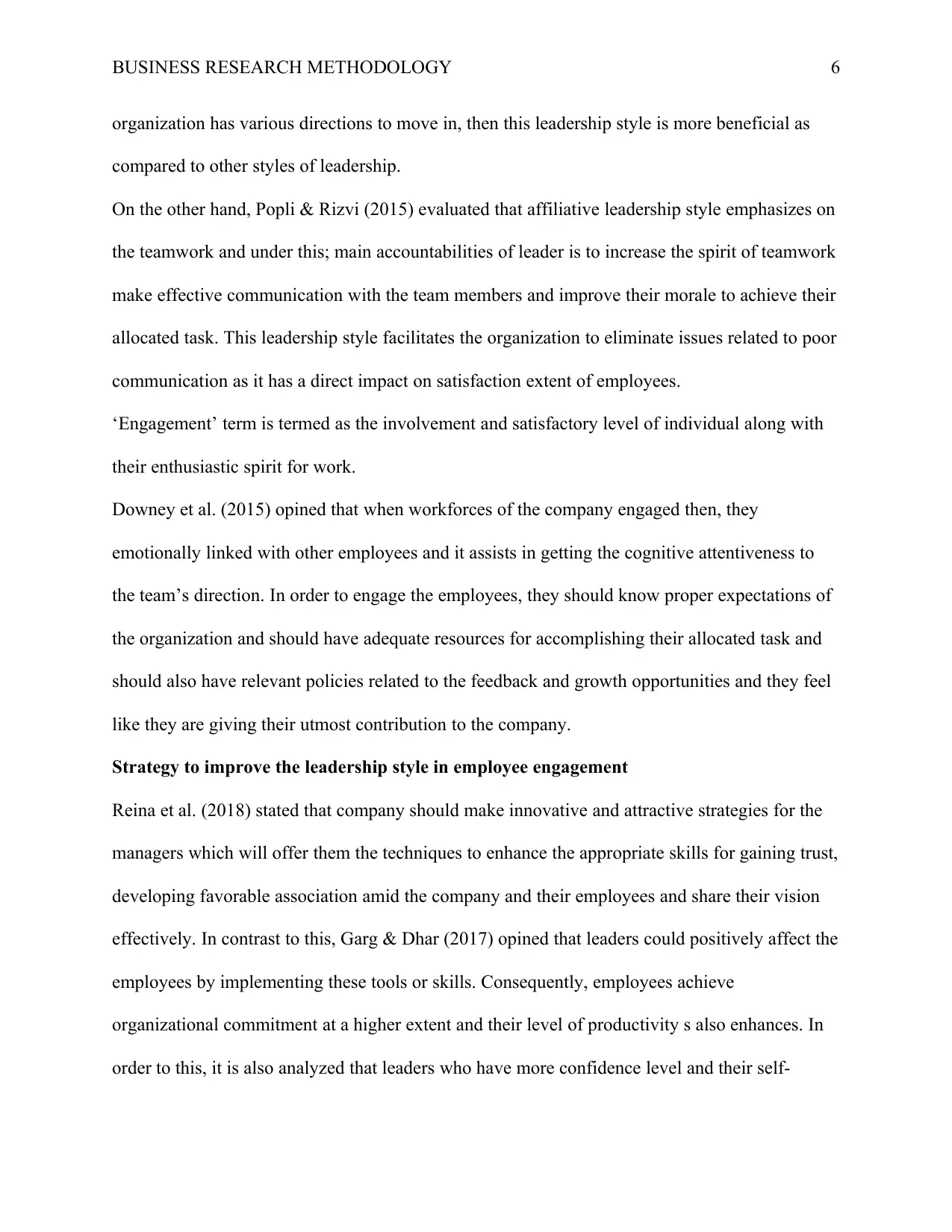
BUSINESS RESEARCH METHODOLOGY 6
organization has various directions to move in, then this leadership style is more beneficial as
compared to other styles of leadership.
On the other hand, Popli & Rizvi (2015) evaluated that affiliative leadership style emphasizes on
the teamwork and under this; main accountabilities of leader is to increase the spirit of teamwork
make effective communication with the team members and improve their morale to achieve their
allocated task. This leadership style facilitates the organization to eliminate issues related to poor
communication as it has a direct impact on satisfaction extent of employees.
‘Engagement’ term is termed as the involvement and satisfactory level of individual along with
their enthusiastic spirit for work.
Downey et al. (2015) opined that when workforces of the company engaged then, they
emotionally linked with other employees and it assists in getting the cognitive attentiveness to
the team’s direction. In order to engage the employees, they should know proper expectations of
the organization and should have adequate resources for accomplishing their allocated task and
should also have relevant policies related to the feedback and growth opportunities and they feel
like they are giving their utmost contribution to the company.
Strategy to improve the leadership style in employee engagement
Reina et al. (2018) stated that company should make innovative and attractive strategies for the
managers which will offer them the techniques to enhance the appropriate skills for gaining trust,
developing favorable association amid the company and their employees and share their vision
effectively. In contrast to this, Garg & Dhar (2017) opined that leaders could positively affect the
employees by implementing these tools or skills. Consequently, employees achieve
organizational commitment at a higher extent and their level of productivity s also enhances. In
order to this, it is also analyzed that leaders who have more confidence level and their self-
organization has various directions to move in, then this leadership style is more beneficial as
compared to other styles of leadership.
On the other hand, Popli & Rizvi (2015) evaluated that affiliative leadership style emphasizes on
the teamwork and under this; main accountabilities of leader is to increase the spirit of teamwork
make effective communication with the team members and improve their morale to achieve their
allocated task. This leadership style facilitates the organization to eliminate issues related to poor
communication as it has a direct impact on satisfaction extent of employees.
‘Engagement’ term is termed as the involvement and satisfactory level of individual along with
their enthusiastic spirit for work.
Downey et al. (2015) opined that when workforces of the company engaged then, they
emotionally linked with other employees and it assists in getting the cognitive attentiveness to
the team’s direction. In order to engage the employees, they should know proper expectations of
the organization and should have adequate resources for accomplishing their allocated task and
should also have relevant policies related to the feedback and growth opportunities and they feel
like they are giving their utmost contribution to the company.
Strategy to improve the leadership style in employee engagement
Reina et al. (2018) stated that company should make innovative and attractive strategies for the
managers which will offer them the techniques to enhance the appropriate skills for gaining trust,
developing favorable association amid the company and their employees and share their vision
effectively. In contrast to this, Garg & Dhar (2017) opined that leaders could positively affect the
employees by implementing these tools or skills. Consequently, employees achieve
organizational commitment at a higher extent and their level of productivity s also enhances. In
order to this, it is also analyzed that leaders who have more confidence level and their self-
⊘ This is a preview!⊘
Do you want full access?
Subscribe today to unlock all pages.

Trusted by 1+ million students worldwide
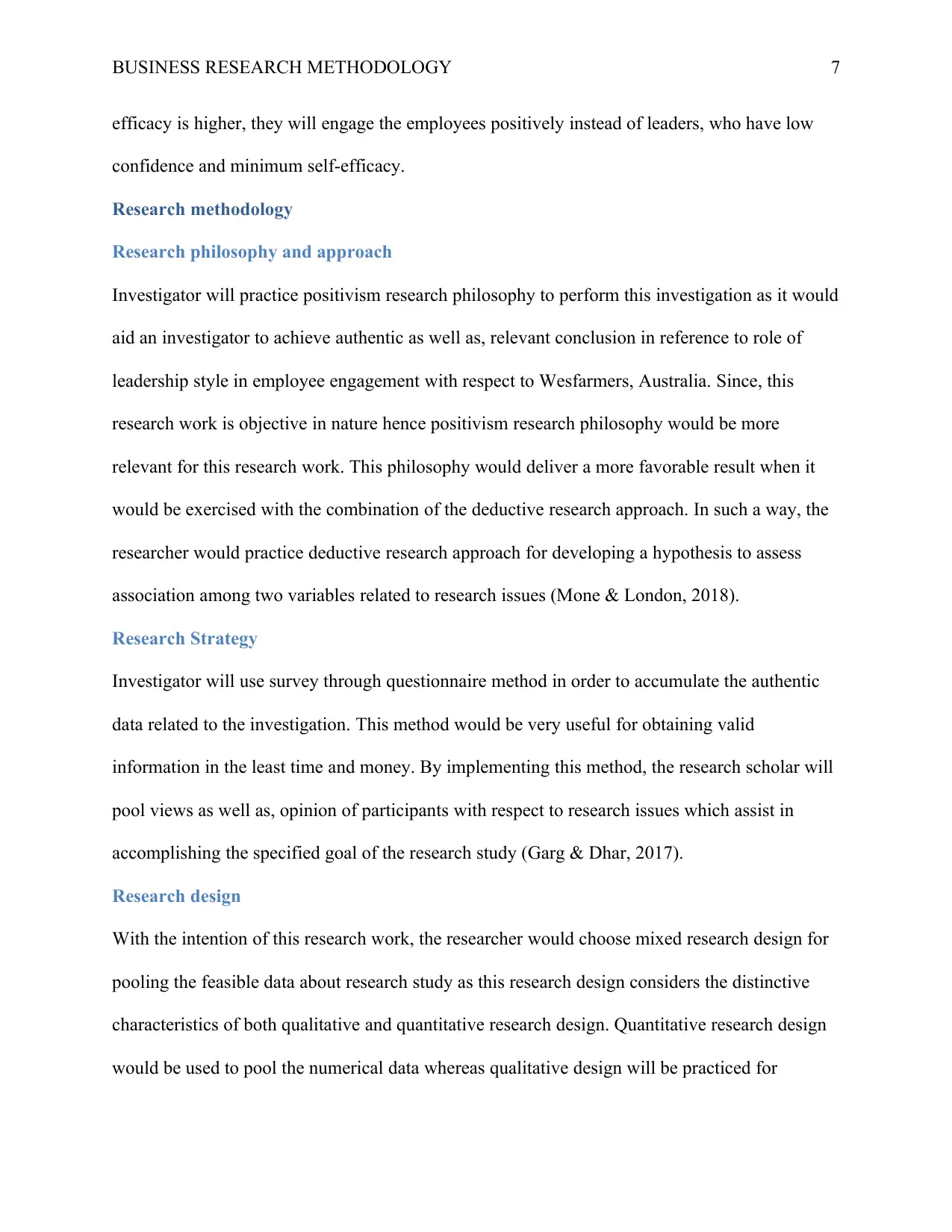
BUSINESS RESEARCH METHODOLOGY 7
efficacy is higher, they will engage the employees positively instead of leaders, who have low
confidence and minimum self-efficacy.
Research methodology
Research philosophy and approach
Investigator will practice positivism research philosophy to perform this investigation as it would
aid an investigator to achieve authentic as well as, relevant conclusion in reference to role of
leadership style in employee engagement with respect to Wesfarmers, Australia. Since, this
research work is objective in nature hence positivism research philosophy would be more
relevant for this research work. This philosophy would deliver a more favorable result when it
would be exercised with the combination of the deductive research approach. In such a way, the
researcher would practice deductive research approach for developing a hypothesis to assess
association among two variables related to research issues (Mone & London, 2018).
Research Strategy
Investigator will use survey through questionnaire method in order to accumulate the authentic
data related to the investigation. This method would be very useful for obtaining valid
information in the least time and money. By implementing this method, the research scholar will
pool views as well as, opinion of participants with respect to research issues which assist in
accomplishing the specified goal of the research study (Garg & Dhar, 2017).
Research design
With the intention of this research work, the researcher would choose mixed research design for
pooling the feasible data about research study as this research design considers the distinctive
characteristics of both qualitative and quantitative research design. Quantitative research design
would be used to pool the numerical data whereas qualitative design will be practiced for
efficacy is higher, they will engage the employees positively instead of leaders, who have low
confidence and minimum self-efficacy.
Research methodology
Research philosophy and approach
Investigator will practice positivism research philosophy to perform this investigation as it would
aid an investigator to achieve authentic as well as, relevant conclusion in reference to role of
leadership style in employee engagement with respect to Wesfarmers, Australia. Since, this
research work is objective in nature hence positivism research philosophy would be more
relevant for this research work. This philosophy would deliver a more favorable result when it
would be exercised with the combination of the deductive research approach. In such a way, the
researcher would practice deductive research approach for developing a hypothesis to assess
association among two variables related to research issues (Mone & London, 2018).
Research Strategy
Investigator will use survey through questionnaire method in order to accumulate the authentic
data related to the investigation. This method would be very useful for obtaining valid
information in the least time and money. By implementing this method, the research scholar will
pool views as well as, opinion of participants with respect to research issues which assist in
accomplishing the specified goal of the research study (Garg & Dhar, 2017).
Research design
With the intention of this research work, the researcher would choose mixed research design for
pooling the feasible data about research study as this research design considers the distinctive
characteristics of both qualitative and quantitative research design. Quantitative research design
would be used to pool the numerical data whereas qualitative design will be practiced for
Paraphrase This Document
Need a fresh take? Get an instant paraphrase of this document with our AI Paraphraser
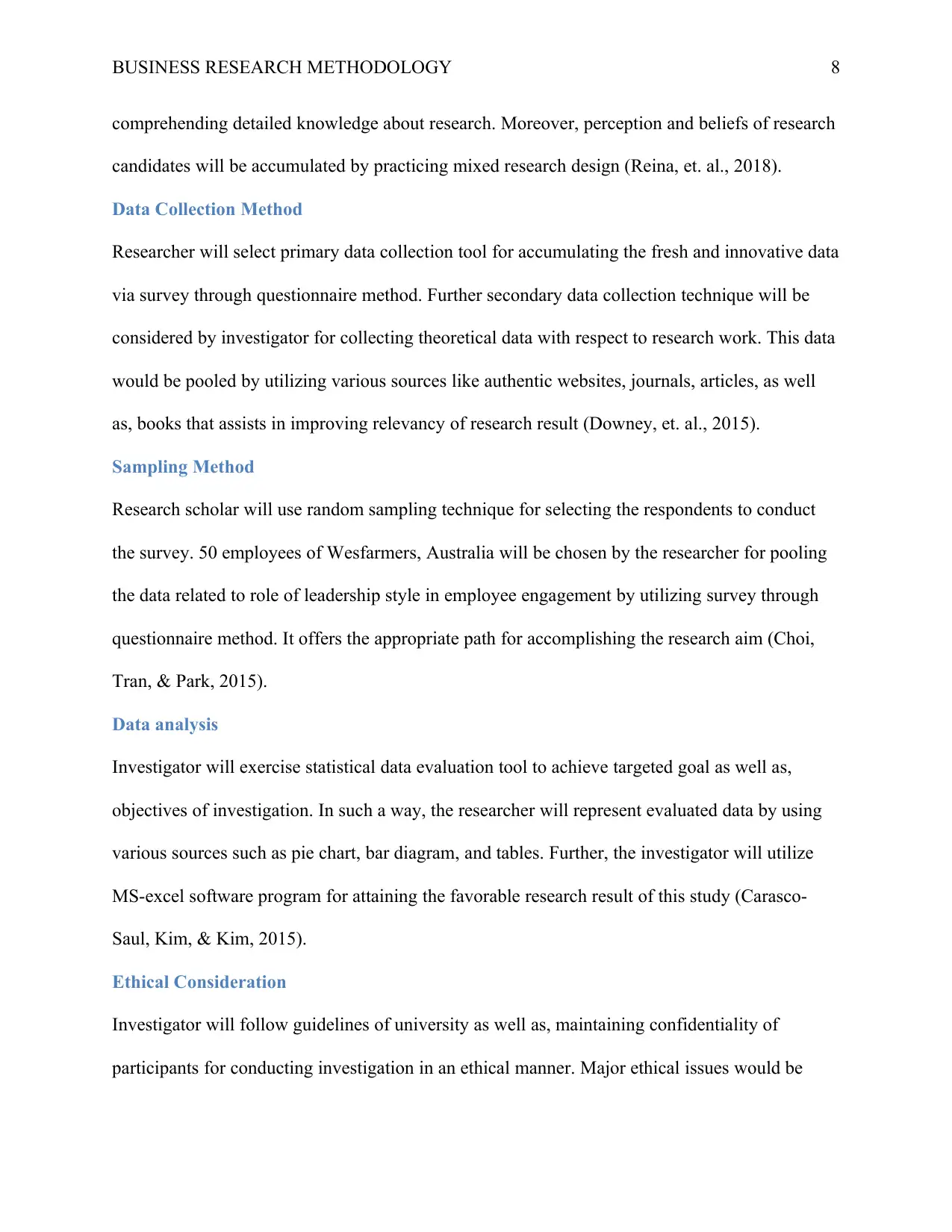
BUSINESS RESEARCH METHODOLOGY 8
comprehending detailed knowledge about research. Moreover, perception and beliefs of research
candidates will be accumulated by practicing mixed research design (Reina, et. al., 2018).
Data Collection Method
Researcher will select primary data collection tool for accumulating the fresh and innovative data
via survey through questionnaire method. Further secondary data collection technique will be
considered by investigator for collecting theoretical data with respect to research work. This data
would be pooled by utilizing various sources like authentic websites, journals, articles, as well
as, books that assists in improving relevancy of research result (Downey, et. al., 2015).
Sampling Method
Research scholar will use random sampling technique for selecting the respondents to conduct
the survey. 50 employees of Wesfarmers, Australia will be chosen by the researcher for pooling
the data related to role of leadership style in employee engagement by utilizing survey through
questionnaire method. It offers the appropriate path for accomplishing the research aim (Choi,
Tran, & Park, 2015).
Data analysis
Investigator will exercise statistical data evaluation tool to achieve targeted goal as well as,
objectives of investigation. In such a way, the researcher will represent evaluated data by using
various sources such as pie chart, bar diagram, and tables. Further, the investigator will utilize
MS-excel software program for attaining the favorable research result of this study (Carasco-
Saul, Kim, & Kim, 2015).
Ethical Consideration
Investigator will follow guidelines of university as well as, maintaining confidentiality of
participants for conducting investigation in an ethical manner. Major ethical issues would be
comprehending detailed knowledge about research. Moreover, perception and beliefs of research
candidates will be accumulated by practicing mixed research design (Reina, et. al., 2018).
Data Collection Method
Researcher will select primary data collection tool for accumulating the fresh and innovative data
via survey through questionnaire method. Further secondary data collection technique will be
considered by investigator for collecting theoretical data with respect to research work. This data
would be pooled by utilizing various sources like authentic websites, journals, articles, as well
as, books that assists in improving relevancy of research result (Downey, et. al., 2015).
Sampling Method
Research scholar will use random sampling technique for selecting the respondents to conduct
the survey. 50 employees of Wesfarmers, Australia will be chosen by the researcher for pooling
the data related to role of leadership style in employee engagement by utilizing survey through
questionnaire method. It offers the appropriate path for accomplishing the research aim (Choi,
Tran, & Park, 2015).
Data analysis
Investigator will exercise statistical data evaluation tool to achieve targeted goal as well as,
objectives of investigation. In such a way, the researcher will represent evaluated data by using
various sources such as pie chart, bar diagram, and tables. Further, the investigator will utilize
MS-excel software program for attaining the favorable research result of this study (Carasco-
Saul, Kim, & Kim, 2015).
Ethical Consideration
Investigator will follow guidelines of university as well as, maintaining confidentiality of
participants for conducting investigation in an ethical manner. Major ethical issues would be
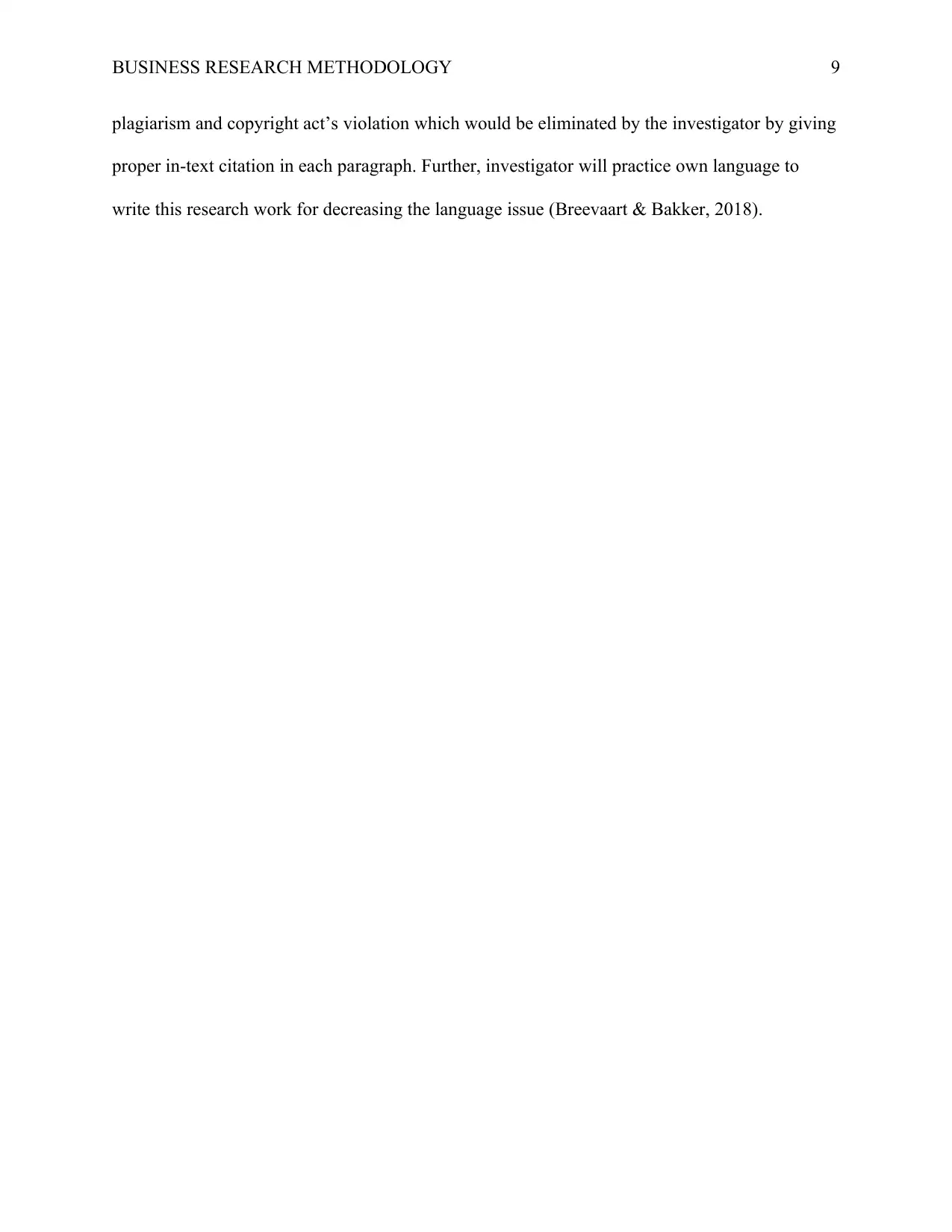
BUSINESS RESEARCH METHODOLOGY 9
plagiarism and copyright act’s violation which would be eliminated by the investigator by giving
proper in-text citation in each paragraph. Further, investigator will practice own language to
write this research work for decreasing the language issue (Breevaart & Bakker, 2018).
plagiarism and copyright act’s violation which would be eliminated by the investigator by giving
proper in-text citation in each paragraph. Further, investigator will practice own language to
write this research work for decreasing the language issue (Breevaart & Bakker, 2018).
⊘ This is a preview!⊘
Do you want full access?
Subscribe today to unlock all pages.

Trusted by 1+ million students worldwide
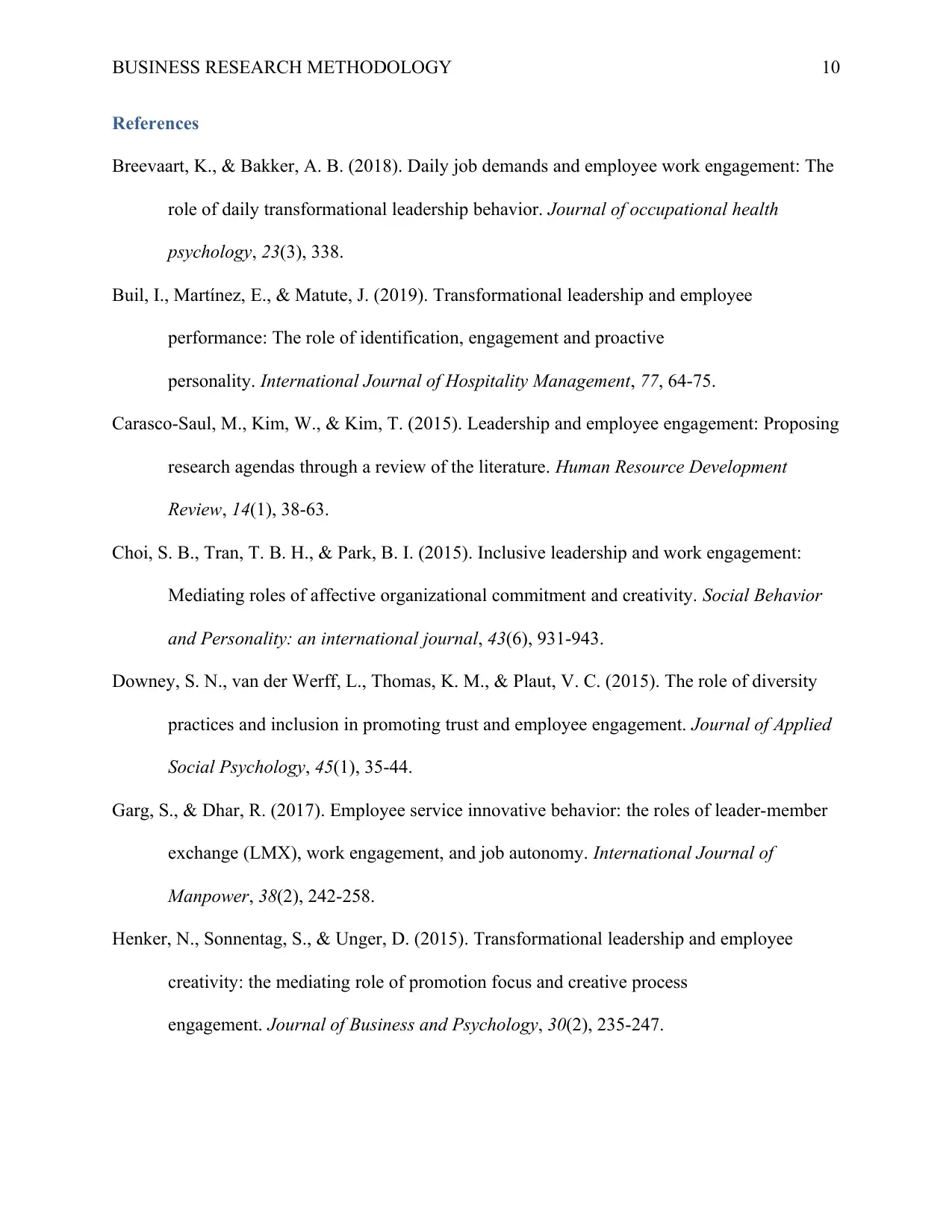
BUSINESS RESEARCH METHODOLOGY 10
References
Breevaart, K., & Bakker, A. B. (2018). Daily job demands and employee work engagement: The
role of daily transformational leadership behavior. Journal of occupational health
psychology, 23(3), 338.
Buil, I., Martínez, E., & Matute, J. (2019). Transformational leadership and employee
performance: The role of identification, engagement and proactive
personality. International Journal of Hospitality Management, 77, 64-75.
Carasco-Saul, M., Kim, W., & Kim, T. (2015). Leadership and employee engagement: Proposing
research agendas through a review of the literature. Human Resource Development
Review, 14(1), 38-63.
Choi, S. B., Tran, T. B. H., & Park, B. I. (2015). Inclusive leadership and work engagement:
Mediating roles of affective organizational commitment and creativity. Social Behavior
and Personality: an international journal, 43(6), 931-943.
Downey, S. N., van der Werff, L., Thomas, K. M., & Plaut, V. C. (2015). The role of diversity
practices and inclusion in promoting trust and employee engagement. Journal of Applied
Social Psychology, 45(1), 35-44.
Garg, S., & Dhar, R. (2017). Employee service innovative behavior: the roles of leader-member
exchange (LMX), work engagement, and job autonomy. International Journal of
Manpower, 38(2), 242-258.
Henker, N., Sonnentag, S., & Unger, D. (2015). Transformational leadership and employee
creativity: the mediating role of promotion focus and creative process
engagement. Journal of Business and Psychology, 30(2), 235-247.
References
Breevaart, K., & Bakker, A. B. (2018). Daily job demands and employee work engagement: The
role of daily transformational leadership behavior. Journal of occupational health
psychology, 23(3), 338.
Buil, I., Martínez, E., & Matute, J. (2019). Transformational leadership and employee
performance: The role of identification, engagement and proactive
personality. International Journal of Hospitality Management, 77, 64-75.
Carasco-Saul, M., Kim, W., & Kim, T. (2015). Leadership and employee engagement: Proposing
research agendas through a review of the literature. Human Resource Development
Review, 14(1), 38-63.
Choi, S. B., Tran, T. B. H., & Park, B. I. (2015). Inclusive leadership and work engagement:
Mediating roles of affective organizational commitment and creativity. Social Behavior
and Personality: an international journal, 43(6), 931-943.
Downey, S. N., van der Werff, L., Thomas, K. M., & Plaut, V. C. (2015). The role of diversity
practices and inclusion in promoting trust and employee engagement. Journal of Applied
Social Psychology, 45(1), 35-44.
Garg, S., & Dhar, R. (2017). Employee service innovative behavior: the roles of leader-member
exchange (LMX), work engagement, and job autonomy. International Journal of
Manpower, 38(2), 242-258.
Henker, N., Sonnentag, S., & Unger, D. (2015). Transformational leadership and employee
creativity: the mediating role of promotion focus and creative process
engagement. Journal of Business and Psychology, 30(2), 235-247.
Paraphrase This Document
Need a fresh take? Get an instant paraphrase of this document with our AI Paraphraser
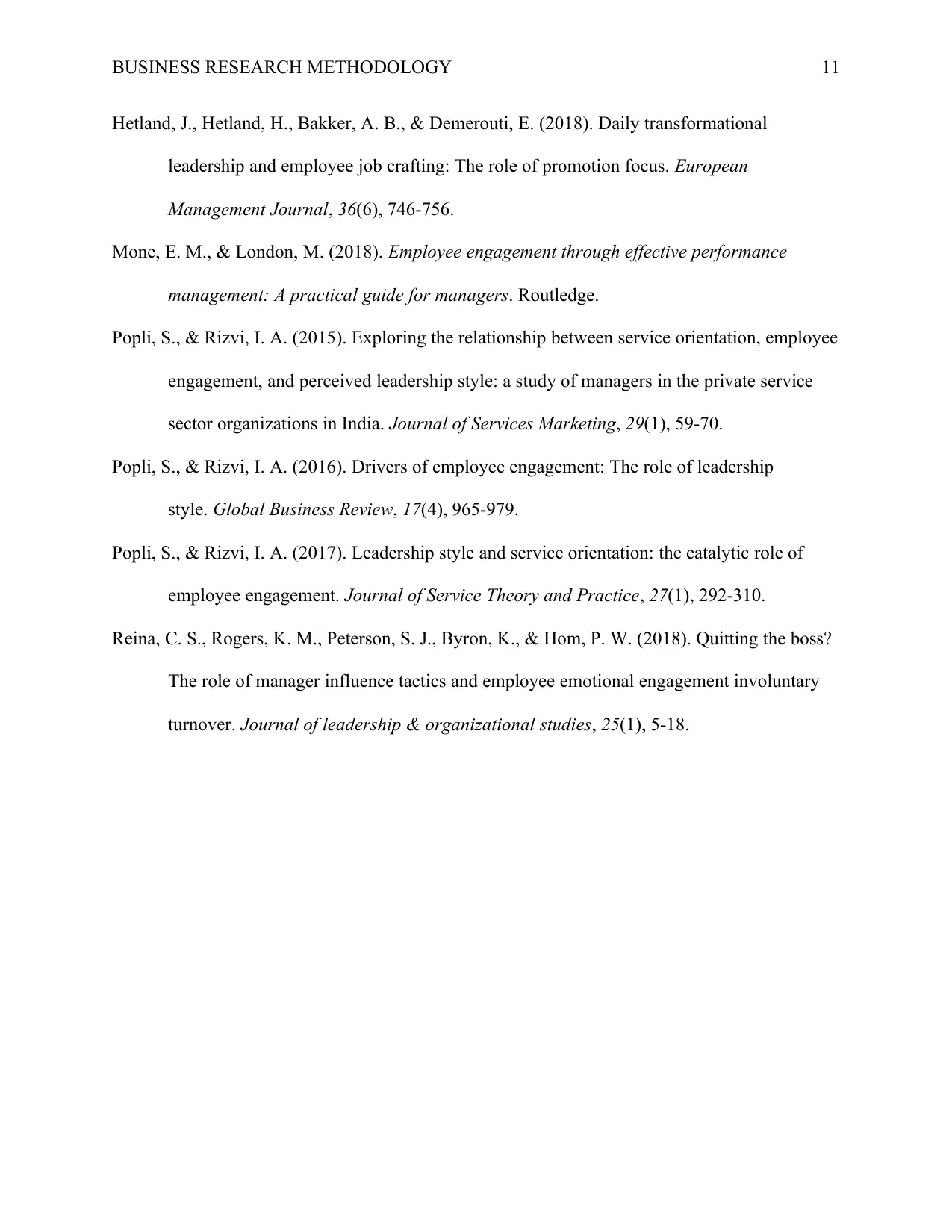
BUSINESS RESEARCH METHODOLOGY 11
Hetland, J., Hetland, H., Bakker, A. B., & Demerouti, E. (2018). Daily transformational
leadership and employee job crafting: The role of promotion focus. European
Management Journal, 36(6), 746-756.
Mone, E. M., & London, M. (2018). Employee engagement through effective performance
management: A practical guide for managers. Routledge.
Popli, S., & Rizvi, I. A. (2015). Exploring the relationship between service orientation, employee
engagement, and perceived leadership style: a study of managers in the private service
sector organizations in India. Journal of Services Marketing, 29(1), 59-70.
Popli, S., & Rizvi, I. A. (2016). Drivers of employee engagement: The role of leadership
style. Global Business Review, 17(4), 965-979.
Popli, S., & Rizvi, I. A. (2017). Leadership style and service orientation: the catalytic role of
employee engagement. Journal of Service Theory and Practice, 27(1), 292-310.
Reina, C. S., Rogers, K. M., Peterson, S. J., Byron, K., & Hom, P. W. (2018). Quitting the boss?
The role of manager influence tactics and employee emotional engagement involuntary
turnover. Journal of leadership & organizational studies, 25(1), 5-18.
Hetland, J., Hetland, H., Bakker, A. B., & Demerouti, E. (2018). Daily transformational
leadership and employee job crafting: The role of promotion focus. European
Management Journal, 36(6), 746-756.
Mone, E. M., & London, M. (2018). Employee engagement through effective performance
management: A practical guide for managers. Routledge.
Popli, S., & Rizvi, I. A. (2015). Exploring the relationship between service orientation, employee
engagement, and perceived leadership style: a study of managers in the private service
sector organizations in India. Journal of Services Marketing, 29(1), 59-70.
Popli, S., & Rizvi, I. A. (2016). Drivers of employee engagement: The role of leadership
style. Global Business Review, 17(4), 965-979.
Popli, S., & Rizvi, I. A. (2017). Leadership style and service orientation: the catalytic role of
employee engagement. Journal of Service Theory and Practice, 27(1), 292-310.
Reina, C. S., Rogers, K. M., Peterson, S. J., Byron, K., & Hom, P. W. (2018). Quitting the boss?
The role of manager influence tactics and employee emotional engagement involuntary
turnover. Journal of leadership & organizational studies, 25(1), 5-18.
1 out of 11
Related Documents
Your All-in-One AI-Powered Toolkit for Academic Success.
+13062052269
info@desklib.com
Available 24*7 on WhatsApp / Email
![[object Object]](/_next/static/media/star-bottom.7253800d.svg)
Unlock your academic potential
Copyright © 2020–2025 A2Z Services. All Rights Reserved. Developed and managed by ZUCOL.



